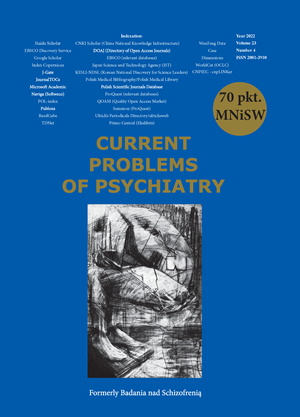A typology of adolescent online gamers. Part I
DOI:
https://doi.org/10.2478/cpp-2022-0020Keywords:
Internet games, typology, adolescentAbstract
Introduction: For several years now, there has been an increased interest on the part of psychiatrists, pediatricians, psychologists, specialists in education, and sociologists in the issue of so-called behavioral addictions, which include Internet addiction and computer gaming addiction. The aim of this study was to draw a typology of Internet gamers.
Material and methods: The examined group and method: The study involved 576 individuals aged 16 to 19 years. The participants were surveyed using an Inquiry Form and the Online Gaming Addiction Questionnaire designed by the present authors.
Results: The participants of this study were divided into four types of online gamers: gamers who scored the highest on the KBUGI scales and items corresponding to the DSM-5 criteria for Internet Gaming Disorder (Type 1); gamers who mostly played violent online games in which the player kills his enemies, destroys things, breaks traffic rules, and experiences power and new sensations (Type 2); individuals who played mainly to eliminate the feeling of boredom, enhance their mood and experience pleasure, new sensations and rivalry (Type 3); and people who only played occasionally and were not at risk of Internet gaming addiction (Type 4).
Conclusions: The four groups included gamers severely addicted to gaming; gamers who played violent games to satisfy their need for aggression (moderate Internet gaming addiction); gamers who played mainly to eliminate boredom and seek new stimuli (mild Internet gaming addiction); and non-addicted gamers.
References
1. Young KS. Internet addiction: the emergence of a new clinical disorder. Cyberpsychol. Behav. 1998;1(3):237–244.10.1089/cpb.1998.1.237
2. American Psychiatric Association. Diagnostic and statistical manual of mental disorders (5th ed.). Arlington, VA: American Psychiatric Publishing; 2013.10.1176/appi.books.9780890425596
3. Müller KW, Janikian M, Dreier M, Wölfling K, Beutel ME, Tzavara C i wsp. Regular gaming behavior and internet gaming disorder in European adolescents: results from a cross-national representative survey of prevalence, predictors, and psychopathological correlates. Eur Child Adolesc Psychiatry, 2015;24(5):565–574.10.1007/s00787-014-0611-225189795
4. Lopez-Fernandez O, Honrubia-Serrano ML, Baguley T, Griffiths MD. Pathological video game playing in Spanish and British adolescents: Towards the exploration of Internet Gaming Disorder symptomatology. Comput. Human Behav. 2014;41:304–312.10.1016/j.chb.2014.10.011
5. Porter G, Starcevic V, Berle D, Fenech P. Recognizing problem video game use. Aust. N. Z. J. Psychiatry. 2010;44(2):120–128.
6. Grüsser SM, Thalemann R, Griffiths MD. Excessive computer game playing: evidence for addiction and aggression? Cyberpsychol. Behav. 2007;10(2):290–292.10.1089/cpb.2006.995617474848
7. Thomas NJ, Martin FH. Video-arcade game, computer game and Internet activities of Australian students: participation habits and prevalence of addiction. Aust. J. Psychol. 2010;62(2):59–66.
8. Kuss DJ, Griffiths MD. Internet gaming addiction: A systematic review of empirical research. Int. J. Ment. Health Addict. 2012;10(2):278–296.
9. Jeong EJ, Kim DW. Social activities, self-efficacy, game attitudes, and game addiction. Cyberpsychol. Behav. Soc. Netw. 2011;14(4):213–221.
10. Potembska E, Pawłowska B. Właściwości psychometryczne Kwestionariusza do Badania Uzależnienia od Gier Internetowych (KBUGI). Curr. Probl. Psychiatry, 2014; 14(3):135–143.
11. Stanisz A. Przystępny kurs statystyki z zastosowaniem STATISTICA PL na przykładach z medycyny. Kraków: StatSoft; 2006.
Downloads
Published
Issue
Section
License
Copyright (c) 2022 Authors

This work is licensed under a Creative Commons Attribution 4.0 International License.


